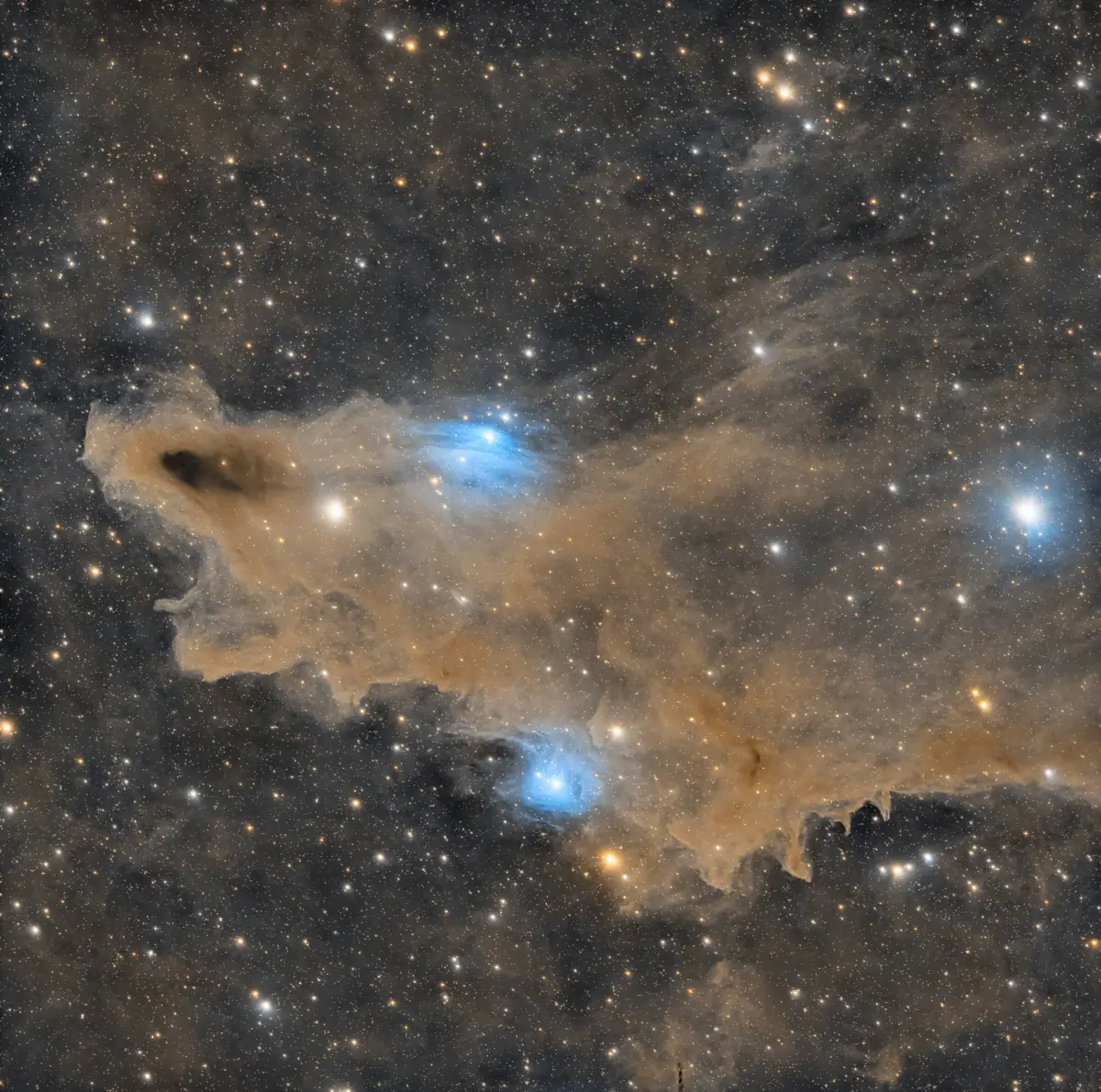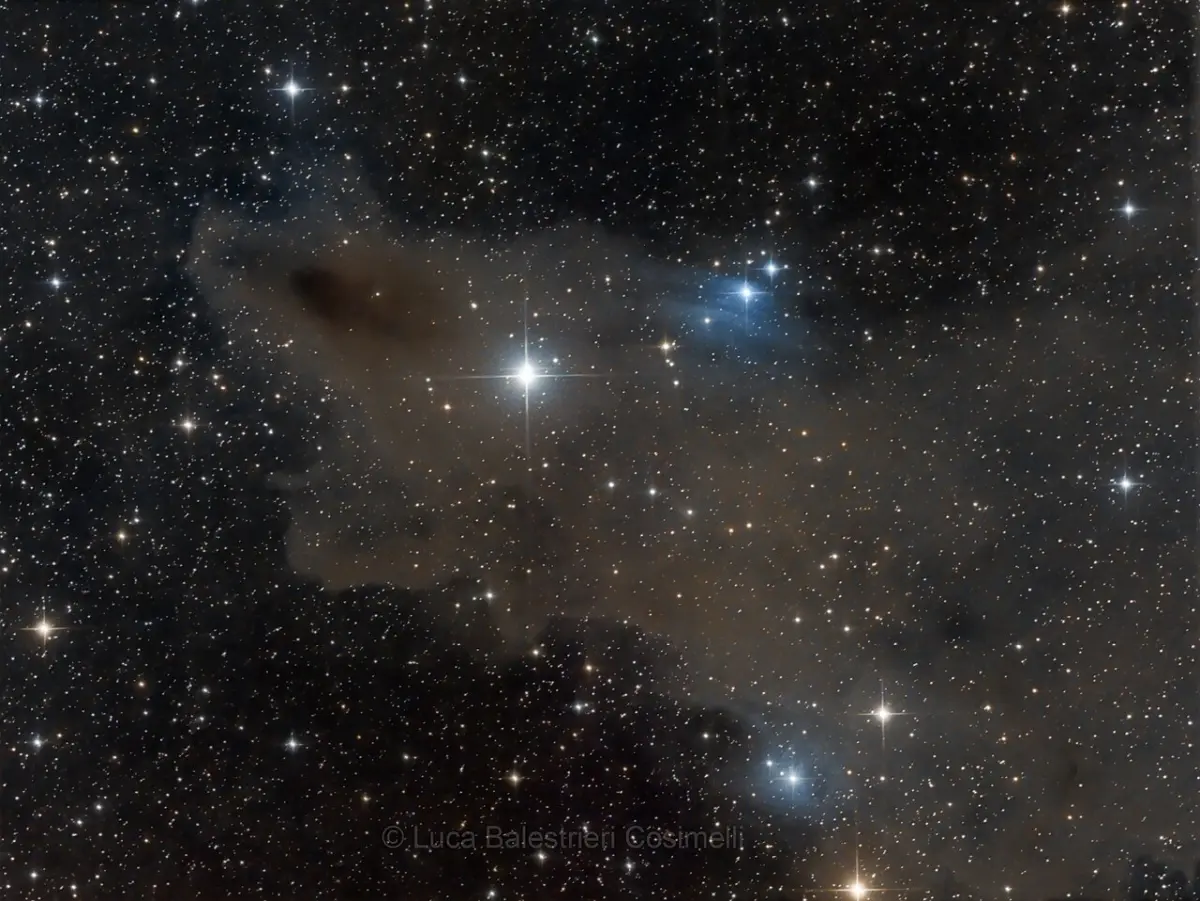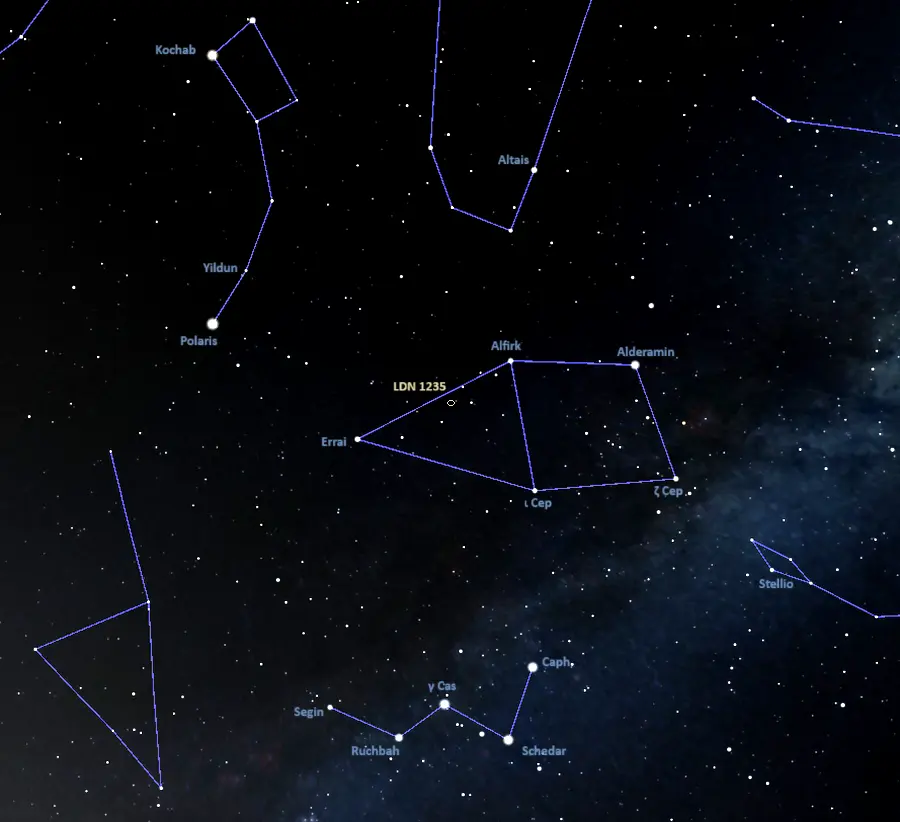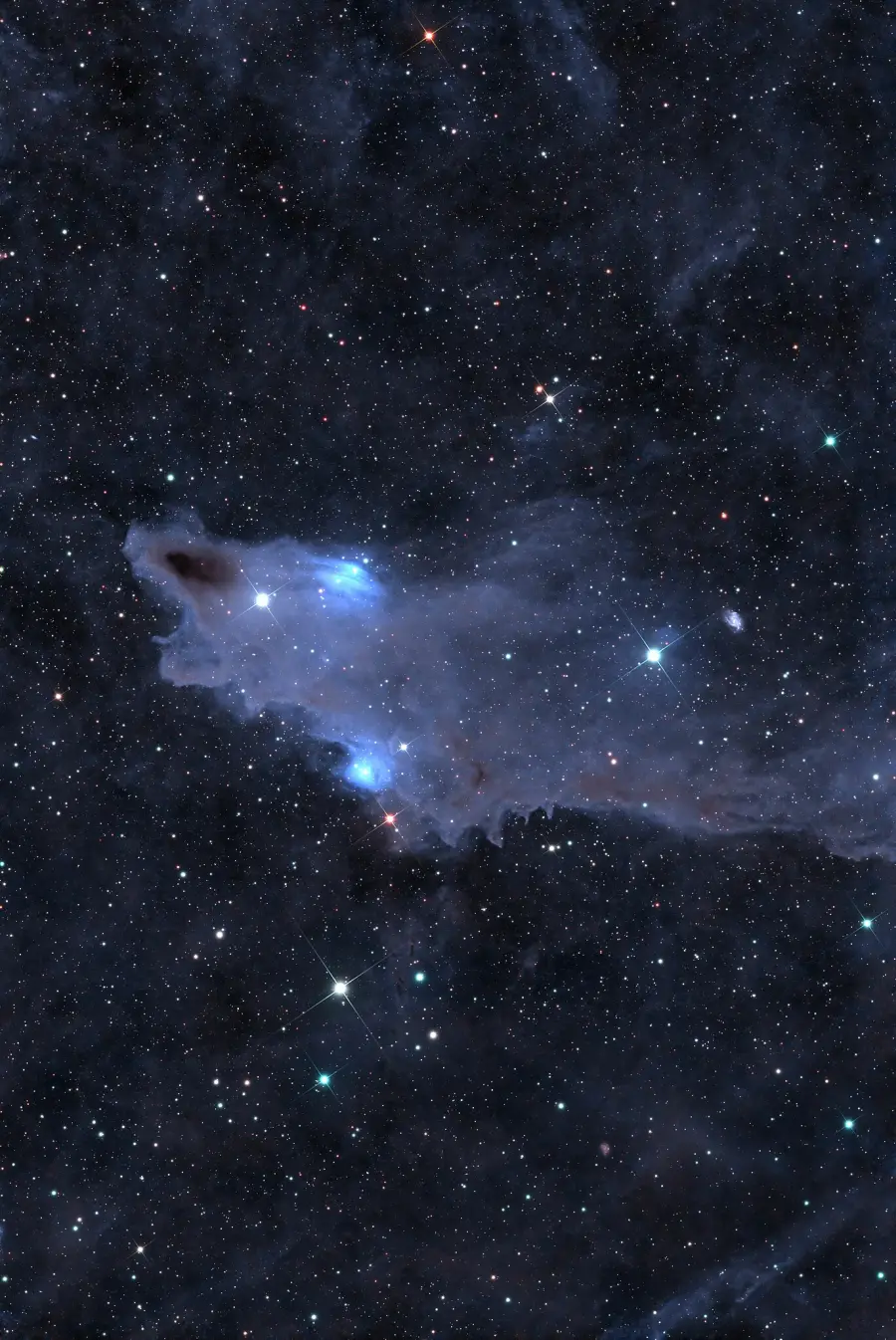The Shark Nebula (or Dark Shark nebula) is a star-forming nebula located approximately 650 light years away in the northern constellation Cepheus (the King). The cloud of interstellar gas and dust appears silhouetted against a rich star field and is part of a larger star-forming region called the Cepheus Flare. It is listed as LDN 1235 in the Lynds Catalogue of Dark Nebulae and LBN 111.07+14.08 in the Lynds Catalogue of Bright Nebulae.
The Shark Nebula has a diameter of about 15 light-years. The faint nebula consists of the dark nebula LDN 1235, which marks the nose or eye of the shark, the blue reflection nebulae LBN 541 and LBN 546, and the faint H II region LBN 111.07+14.08 (LBN 535). The interstellar gas cloud is composed mainly of hydrogen and helium, with trace amounts of other elements, such as carbon, oxygen and nitrogen.
The entire complex associated with the cosmic Shark is one of the several known regions of star formation in the Cepheus Flare region. Others include LDN 1251, LDN 1217, LDN 1219, LDN 1177, NGC 7023, LDN 1148, LDN 1158 and LDN 1228.

Shark Nebula (LDN 1235), image credit: Chuck Ayoub (CC0 1.0)
Cepheus Flare is a large complex of dense molecular clouds and young stellar objects (YSOs) approximately 300 – 500 pc (978 – 1631 ly) from the Sun. The stellar nursery lies in a region of the sky close to Polaris and the northern celestial pole.
The dark nebula LBN 1235 is the densest part of the large molecular cloud that contains a star forming region. The young stars that form in the nebula are between 1 and 5 million years old. The dark absorption nebula is composed of thick microscopic dust grains that block the visible light of the background stars and deep sky objects, creating the shape of the shark.
The Shark Nebula is believed to be an extended red emission nebula (ERE). The dust in the nebula emits a faint red photoluminescence as it gets energized by the intense ultraviolet light of the young stars in the nebula. The dust grains re-emit the absorbed starlight, producing regions with a subtly red glow.
The known stellar population associated with the Shark Nebula includes the Herbig Ae star SV Cephei, three classical T Tauri stars, and the B-type young stellar objects BD +72°1018 and BD +72°1020 (HD 210806), which illuminate the two small reflection nebulae embedded in the Shark Nebula. These blue nebulae appear near the shark’s head.
A 2021 study identified a total of 68 candidate members that share a common proper motion with the T Tauri stars and the B-type stars in the Shark Nebula. The detection of these comoving stars associated with the cosmic Shark indicates that the nebula contains the richest cluster in the Cepheus Flare region.
Facts
The Shark Nebula was discovered in the 1960s. In 1962, American astronomer Beverly Turner Lynds listed the dark part of the nebula as LDN 1235 in her Catalogue of Dark Nebulae. Lynds found the nebula on the photographic plates obtained in the National Geographic Palomar Observatory Sky Survey (POSS). The plates were obtained with the 48-inch Oschin Schmidt telescope at the Palomar Observatory in California. The catalogue was published in The Astrophysical Journal Supplement, vol. 7, in May 1962.
In 1965, Lynds included the whole nebula as LBN 111.07+14.08 (LBN 535) in her Catalogue of Bright Nebulae. She also included the two small reflection nebulae in the region as LBN 541 and LBN 546. These nebulae were discovered by the German astronomers J. Dorschner and J. Gürtler on the Palomar Observatory Sky Survey plates in 1963.
In 1966, Dutch Canadian astronomer Sidney van den Bergh found the nebula LBN 541 to be illuminated by the star BD +72 1018 and LBN 546 by the star BD +72 1020. Both these stars are in fact young stellar objects that have not yet reached the main sequence. Van den Bergh included the two nebulae as vdB 149 and vdB 150 in his Van den Bergh Catalogue of Reflection Nebulae of 1966.

Shark Nebula, image credit: Wikimedia Commons/LuxBC (CC BY-SA 4.0)
Location
The Shark Nebula is located in Cepheus, one of the northernmost constellations in the sky. It appears in the region between the massive blue variable star Alfirk (Beta Cephei) and the orange giant Errai (Gamma Cephei). The nebula is too faint to be observed in small and medium telescopes. It is best seen in long-exposure photographs.
The constellation figure of Cepheus, which looks like a stick house drawn by a child, can be found using the brighter stars of the neighbouring Cassiopeia. A line extended from Schedar through Caph in Cassiopeia’s W points in the direction of Alderamin, the brightest star in Cepheus. Alderamin forms the base of the stick house with the fainter Zeta Cephei, while Errai and Alfirk are part of the roof.
At declination +73° 25′, the Shark Nebula never appears above the horizon for observers south of the latitude 16° S.

Location of the Shark Nebula, image: Stellarium
Shark Nebula – LDN 1235
| Constellation | Cepheus |
| Object type | H II region, dark nebula |
| Right ascension | 22h 14m 55.0s |
| Declination | +73° 25′ 00″ |
| Apparent size | 10.2’ x 4.2’ |
| Distance | 650 light years |
| Size | 15 light-years |
| Names and designations | Shark Nebula, LDN 1235, TGU H725 P1 |

LDN 1235 is a dark/reflection nebula in the constellation Cepheus approximately 650 light-years away. The nebulosity is composed of interstellar dust that hides most of the light from behind it. LDN 1235 is most likely an extended red emission nebula (ERE). EREs shine by photoluminescence when dust particles are hit by high energy radiation. Also shown in this image are two reflection nebulae, van den Bergh 149 (vdB 149) and vdB 150. The dust cloud resembles the shape of a shark and spans approximately 15 light-years head-to-tail. Due to its unique shape, it is popularly known as the Shark Nebula. NASA selected the Shark Nebula as its Astronomy Picture of the Day on June 14, 2023 based on a submission from an amateur astronomer, Stephen Kennedy, taken from a ground-based telescope. Image credit: Stephen Andrew Kennedy of Strawn, Texas (CC BY-SA 4.0)